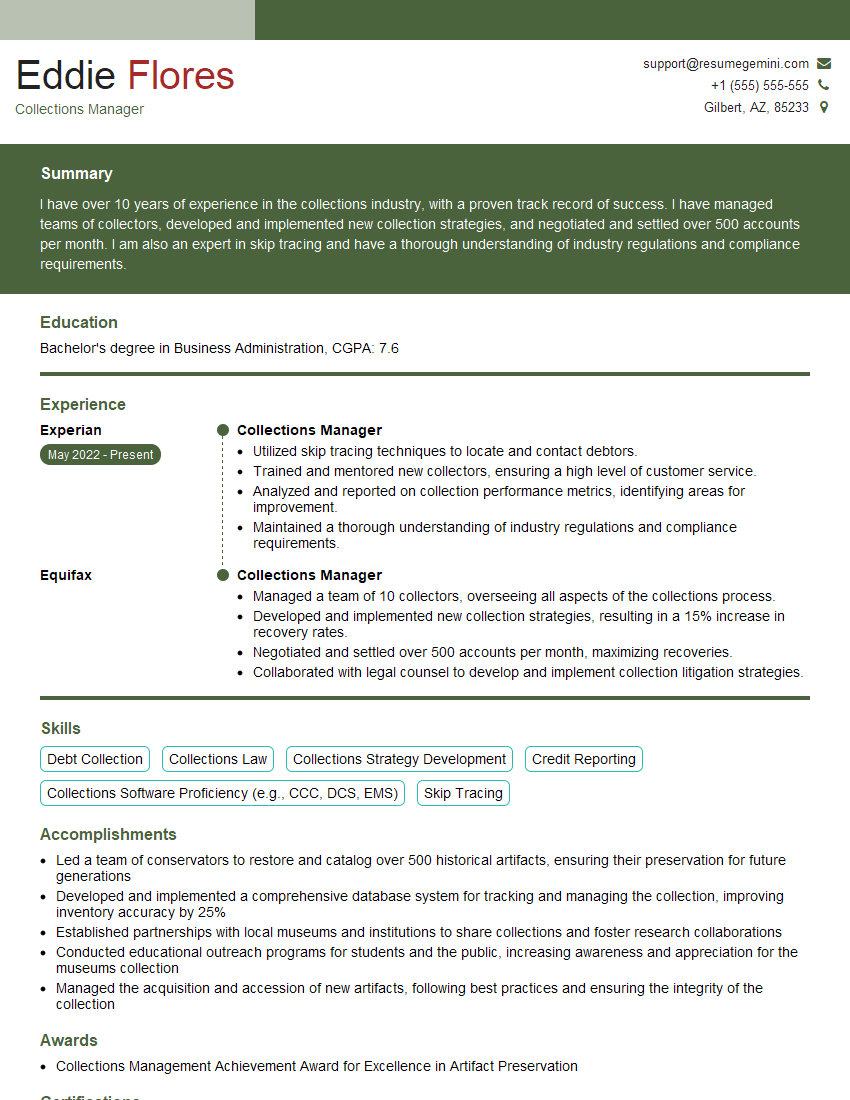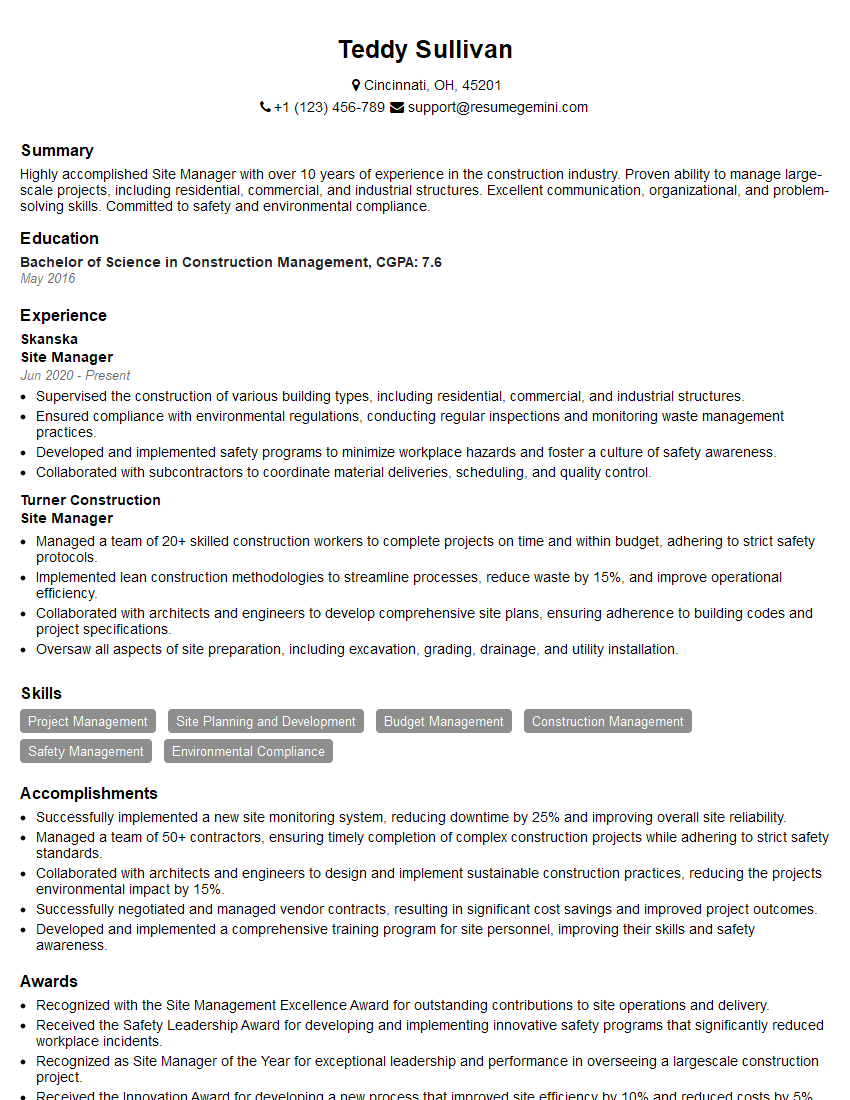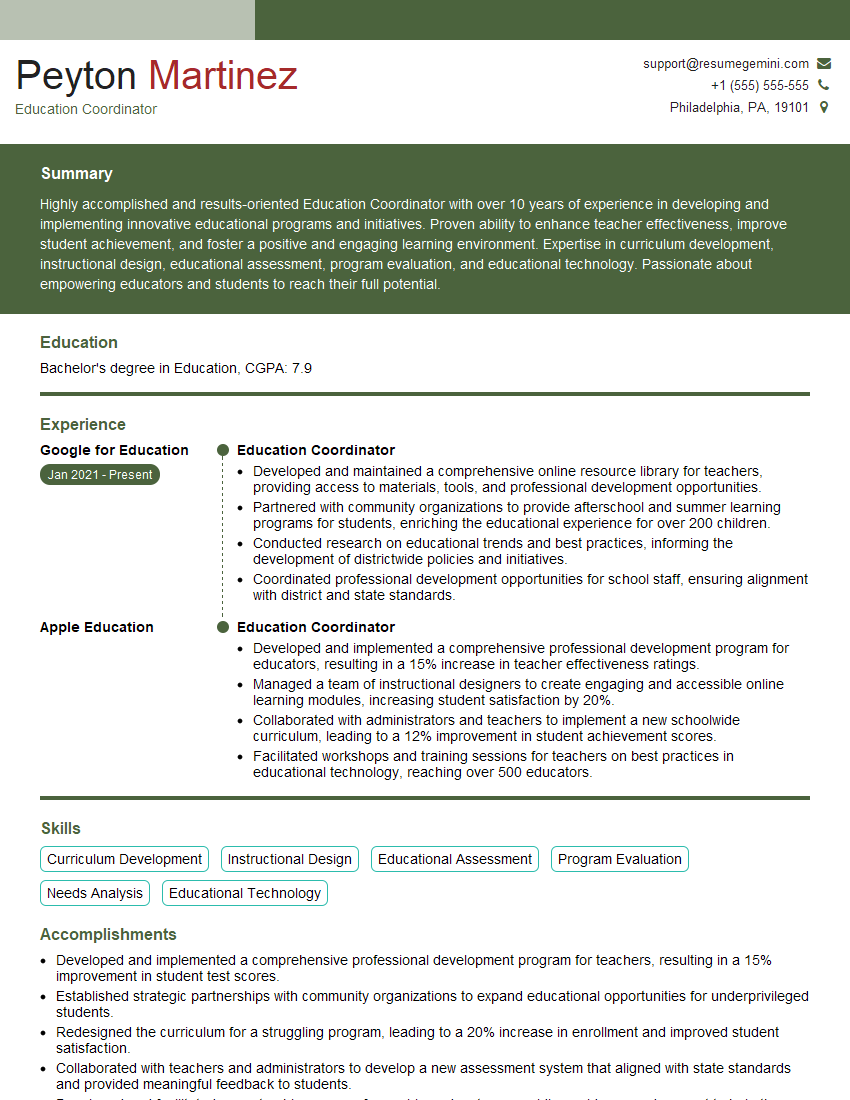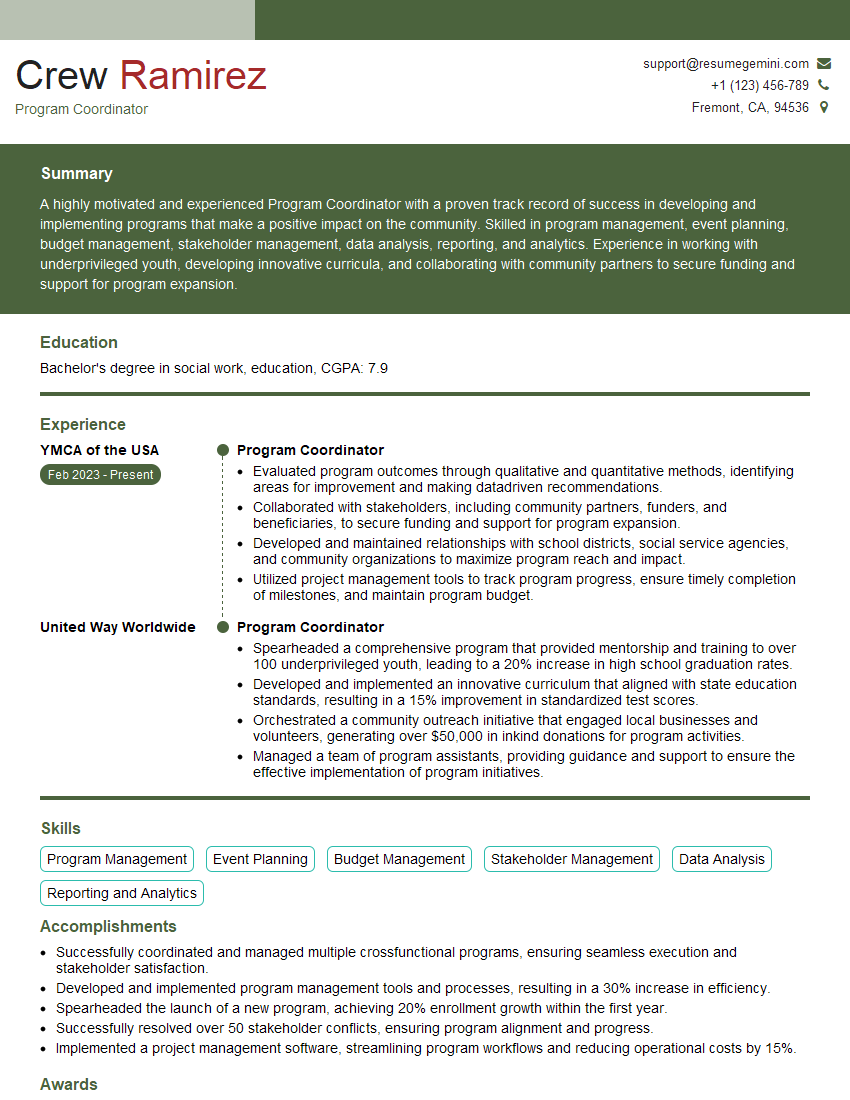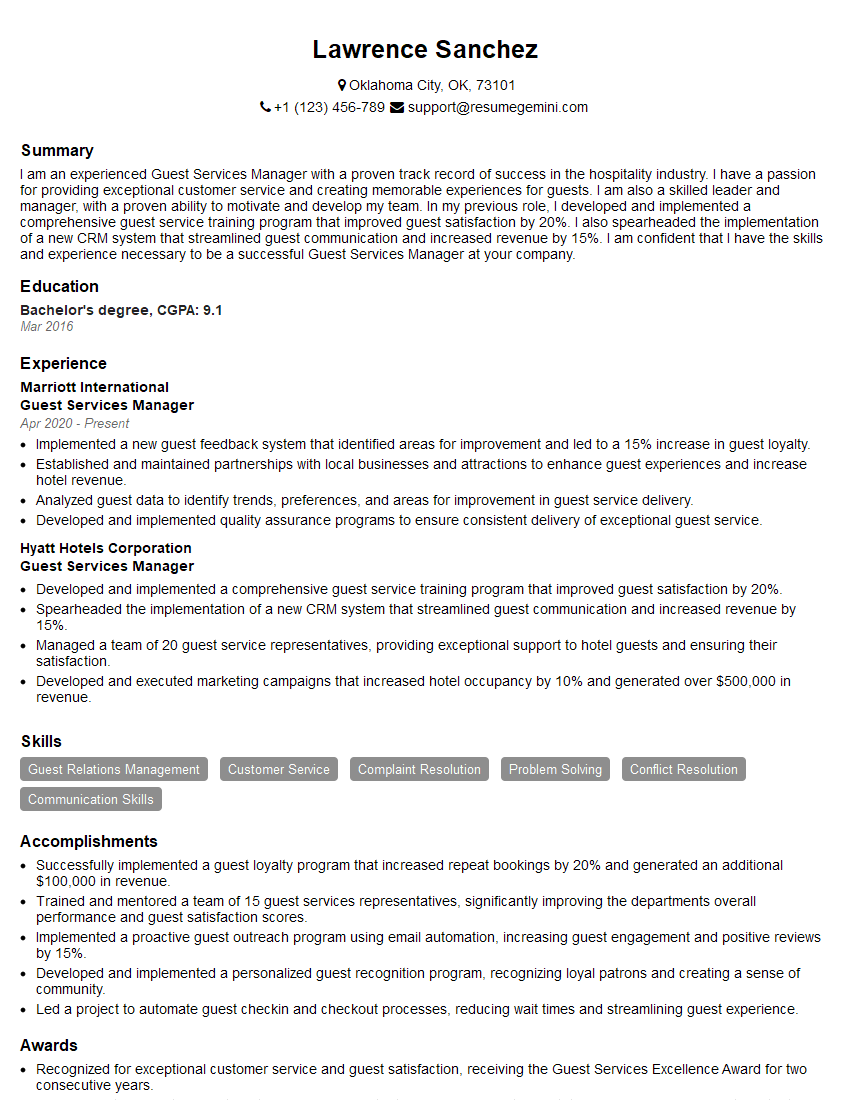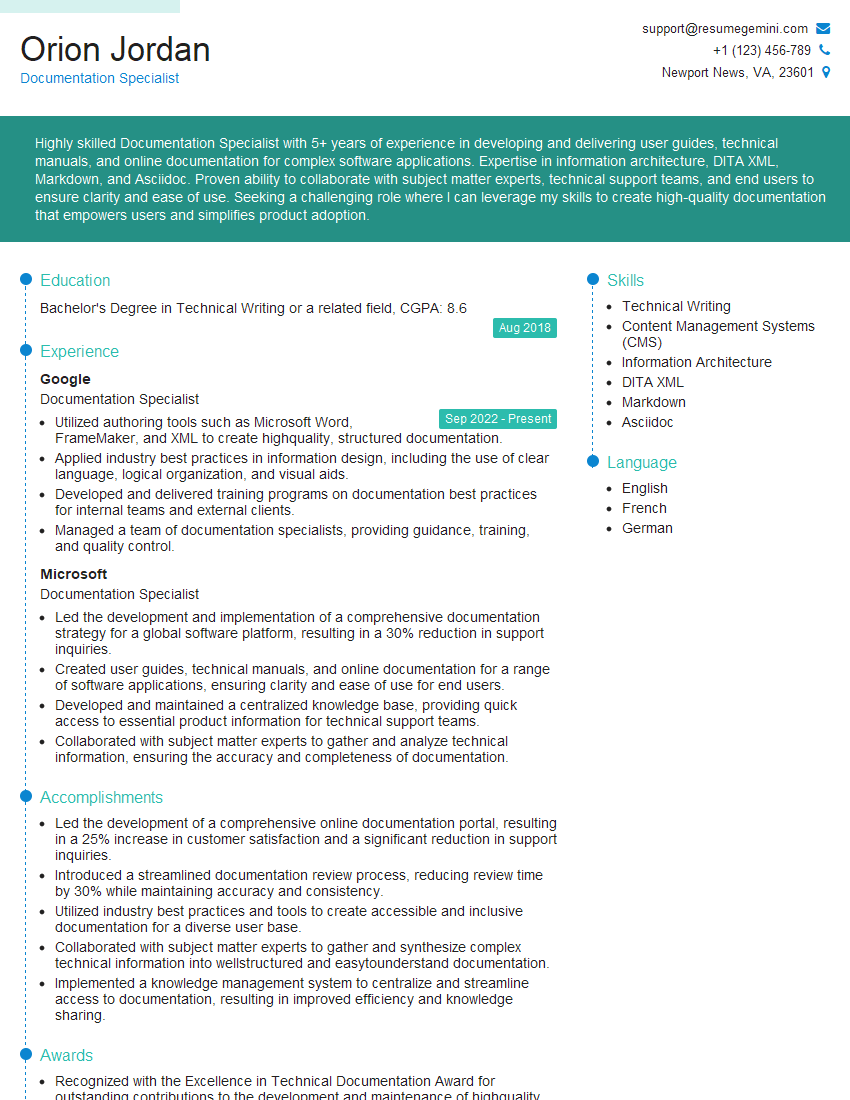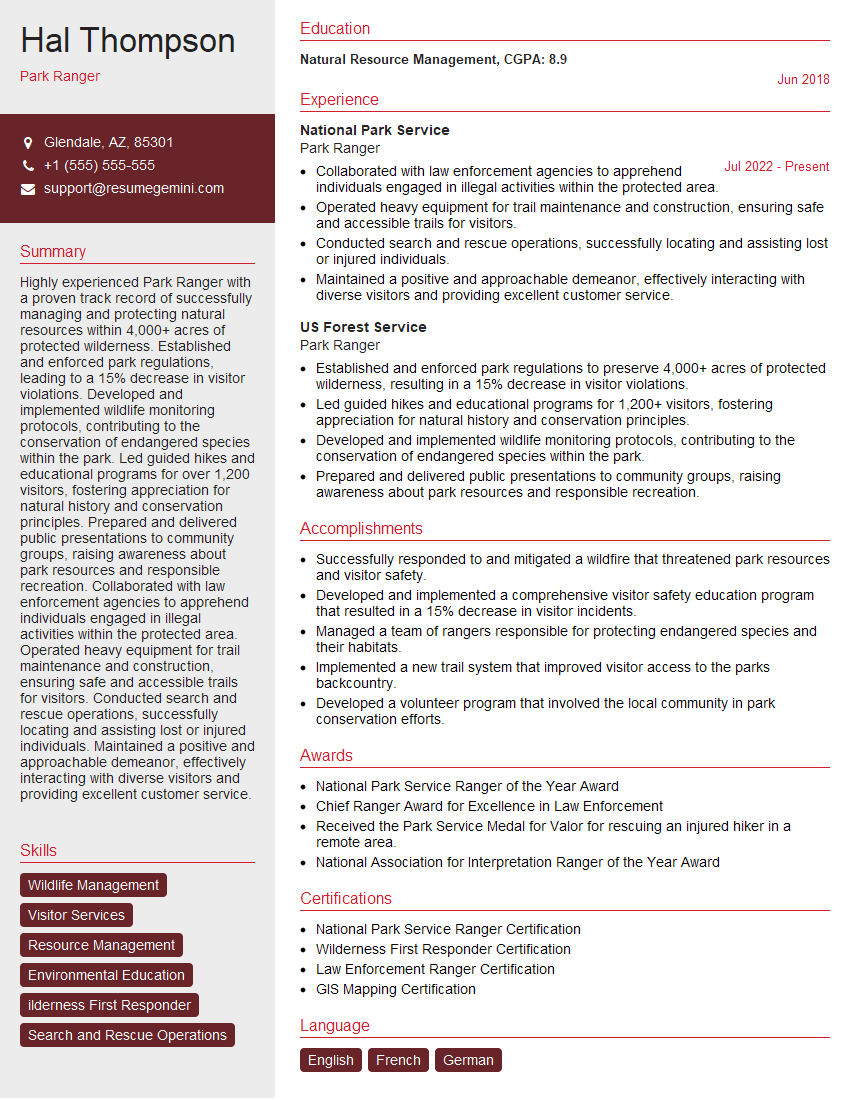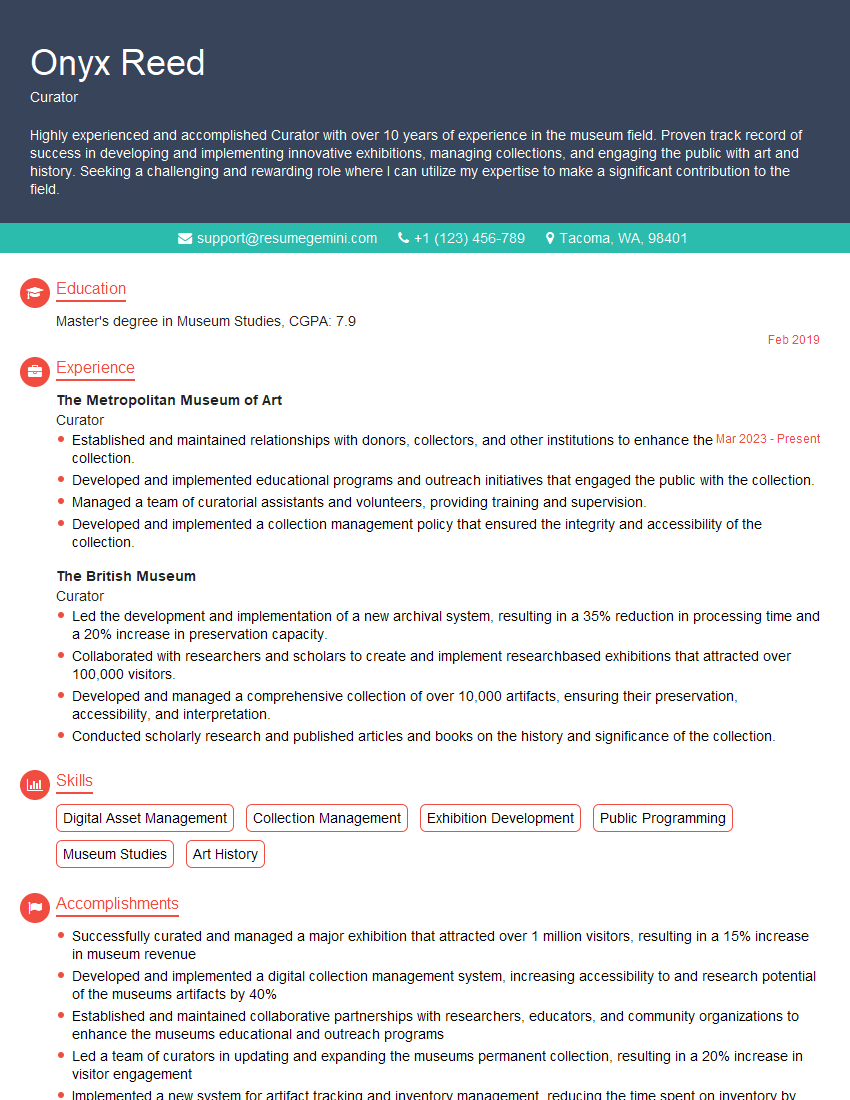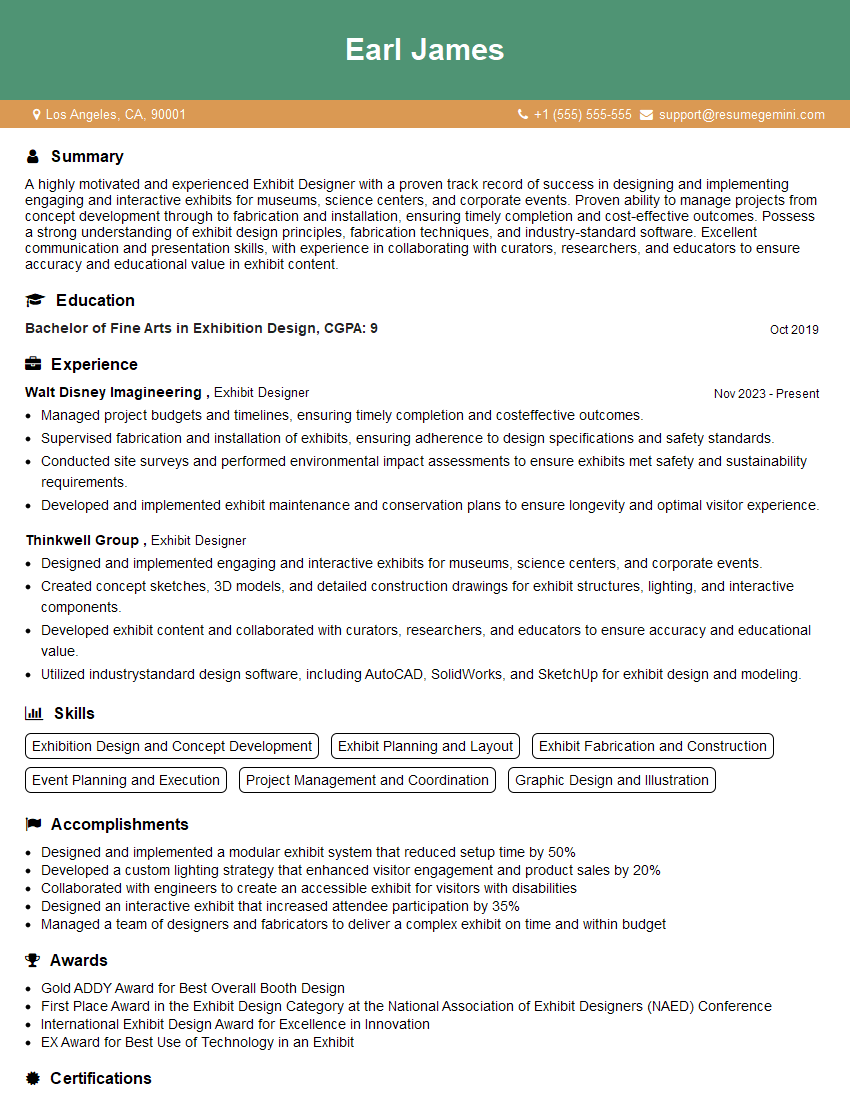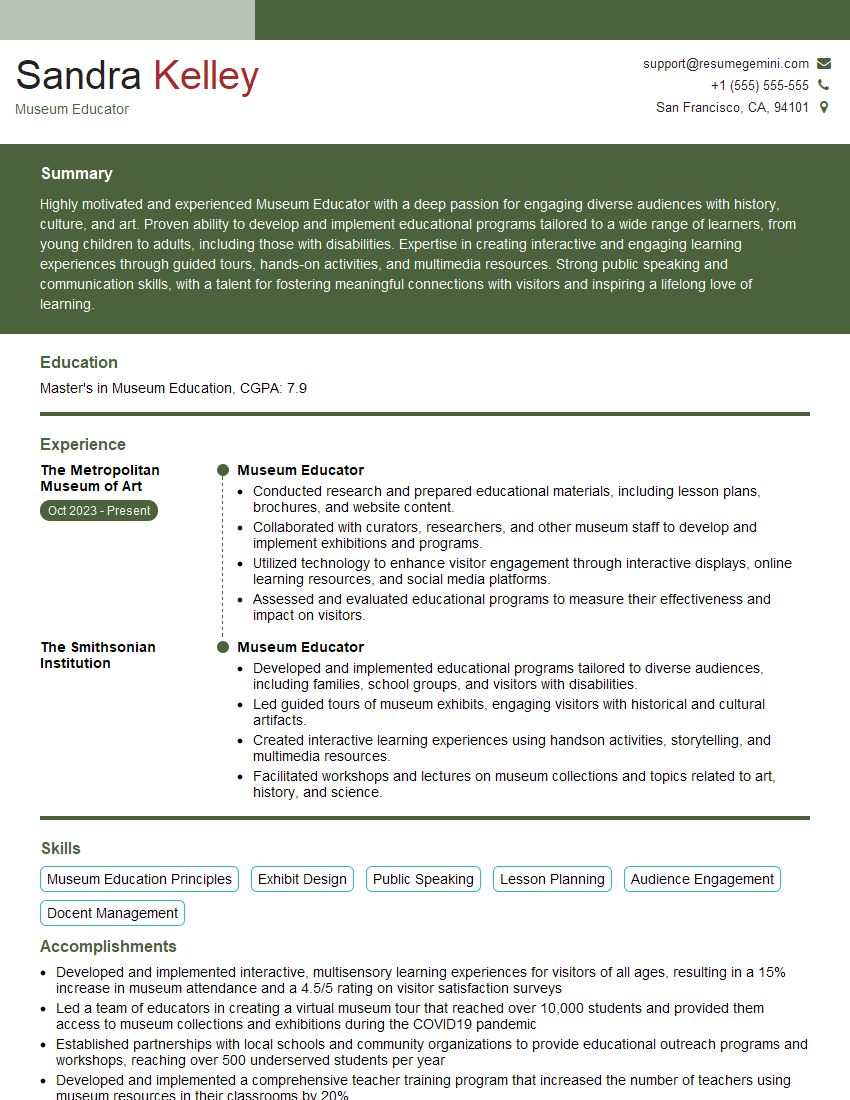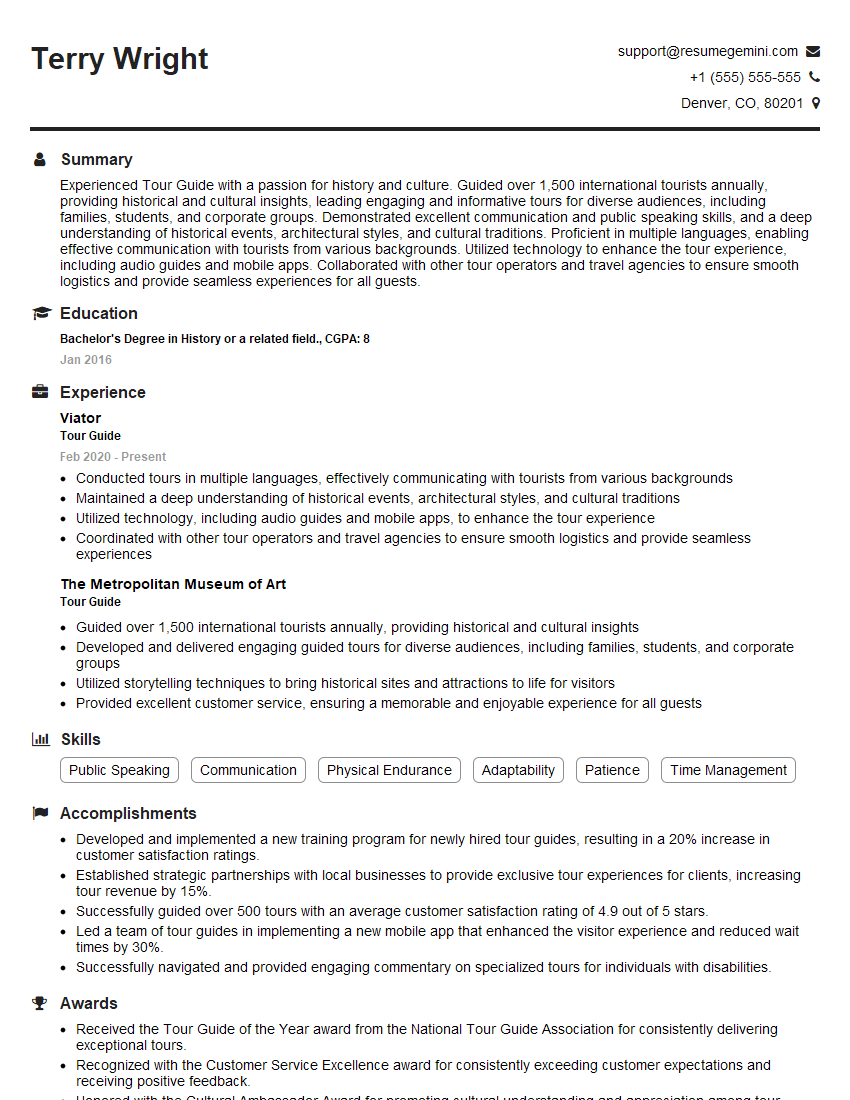Are you ready to stand out in your next interview? Understanding and preparing for Historical Site Interpretation interview questions is a game-changer. In this blog, we’ve compiled key questions and expert advice to help you showcase your skills with confidence and precision. Let’s get started on your journey to acing the interview.
Questions Asked in Historical Site Interpretation Interview
Q 1. Describe your experience developing interpretive programs for diverse audiences.
Developing interpretive programs for diverse audiences requires a nuanced understanding of varying needs and perspectives. My approach centers on audience research – understanding age ranges, cultural backgrounds, educational levels, and interests. For example, when creating a program for a historical site with a significant immigrant population, I would prioritize multilingual resources and narratives that reflect their experiences, ensuring their stories are not marginalized. I also employ differentiated programming, offering tailored experiences like sensory-friendly tours for individuals with disabilities or interactive workshops for younger audiences. This might include incorporating tactile elements in exhibits or using storytelling techniques adapted for different age groups, ranging from simple narratives for young children to more complex historical analyses for adults.
- Example: For a Civil War battlefield, I’d develop separate programs: a family-friendly scavenger hunt, a guided tour focusing on military strategy, and a deeper dive into the social and economic impacts of the war for adult history buffs.
Q 2. Explain your approach to creating engaging and accessible historical narratives.
Creating engaging and accessible historical narratives necessitates moving beyond simple fact-listing. I employ several techniques: First, I focus on storytelling – weaving together historical facts with human stories to create an emotional connection. Think less about dates and figures and more about the lives and motivations of individuals who lived through these events. Second, I prioritize clarity and conciseness, avoiding jargon and using everyday language. Third, I use multiple media to cater to diverse learning styles – images, audio recordings, interactive displays, and even role-playing activities. Accessibility also means considering different literacy levels, providing transcripts for audio-visual materials and simplified explanations for complex concepts.
- Example: Instead of just stating “The Battle of Gettysburg lasted three days,” I’d describe a soldier’s experience on that battlefield – his fear, his hopes, his struggles – using primary source accounts where possible.
Q 3. How do you evaluate the effectiveness of your interpretive methods?
Evaluating interpretive effectiveness involves a multi-pronged approach. Quantitative methods, like visitor surveys and attendance figures, provide valuable data on program popularity. However, I also employ qualitative methods to gauge the impact of the interpretation. This includes informal feedback from visitors, focus groups, and observations of visitor behavior at the site. I look for evidence of engagement, such as questions visitors ask, the length of time they spend at exhibits, and their overall reactions. Post-visit surveys help to understand the level of knowledge gained and the visitor’s overall satisfaction. Analyzing this data helps me to identify areas for improvement and refine my methods.
- Example: If visitor surveys reveal low understanding of a particular exhibit, I’d revise the text or incorporate additional interactive elements to improve comprehension.
Q 4. What strategies do you employ to ensure accuracy and authenticity in historical presentations?
Ensuring accuracy and authenticity in historical presentations is paramount. My approach starts with rigorous research using primary sources whenever possible – diaries, letters, photographs, official documents. I meticulously cross-reference information from multiple sources to verify accuracy. I also consult with subject matter experts, such as historians and archaeologists, to ensure factual correctness and avoid bias. When presenting potentially controversial topics, I strive for objectivity and transparency, presenting different perspectives fairly and acknowledging the complexities of historical events. It’s crucial to disclose any interpretative choices and to avoid presenting historical narratives as definitive truths.
- Example: When interpreting a controversial event, I might include multiple perspectives, acknowledging the lack of consensus on certain aspects and clearly identifying the sources of different interpretations.
Q 5. Describe your experience using various interpretive media (e.g., exhibits, tours, digital resources).
My experience encompasses a broad range of interpretive media. I’ve designed and implemented traditional exhibits using text panels, artifacts, and models; developed engaging guided tours incorporating storytelling and interactive elements; and created digital resources like interactive maps, virtual tours, and educational websites. Each medium offers unique opportunities to engage audiences, but selecting the appropriate medium depends on the site, the target audience, and the message. For example, a digital resource might be ideal for reaching a wider audience than a physical exhibit, while a guided tour allows for immediate interaction and feedback. The key is to integrate these media effectively to create a cohesive and impactful visitor experience.
- Example: For a museum exhibit on a local community, I’d use photographs, oral history recordings, and interactive displays to bring the stories of past residents to life.
Q 6. How do you incorporate diverse perspectives and voices into your interpretations?
Incorporating diverse perspectives is crucial for creating inclusive and representative interpretations. This involves actively seeking out and amplifying marginalized voices – those of women, people of color, indigenous peoples, and other historically underrepresented groups. This may involve using primary source materials from these groups, partnering with community organizations, and consulting with experts on issues of diversity and representation. It also requires acknowledging historical biases and power dynamics and presenting historical narratives in a way that challenges traditional interpretations and promotes a more nuanced and complete understanding of the past.
- Example: When interpreting a historical event, I wouldn’t just focus on the perspectives of the dominant group; I’d also explore the experiences and viewpoints of those who were marginalized or oppressed during that period.
Q 7. How do you adapt your interpretive approach to different site contexts and audiences?
Adapting my interpretive approach requires flexibility and a deep understanding of the specific context. Different sites have unique historical narratives, physical constraints, and target audiences. For instance, a battlefield requires a different approach than a museum or a historical home. Audience considerations are key – a program for school children will differ significantly from one for adult history enthusiasts. I carefully assess the site’s characteristics, potential limitations, and target demographics before designing any interpretive program. This might involve modifying the length and format of tours, adjusting the language and complexity of exhibits, and incorporating interactive elements to enhance engagement across various learning styles.
- Example: For an outdoor site with limited accessibility, I’d focus on providing printed materials and audio tours in addition to in-person programming. For a site with a significant child audience, I’d incorporate hands-on activities and interactive storytelling.
Q 8. Explain your experience working with diverse teams and stakeholders.
Throughout my career, I’ve collaborated extensively with diverse teams, including historians, archaeologists, educators, designers, community members, and site managers. Effective collaboration requires understanding different perspectives and communication styles. For instance, while working on the interpretation plan for a historic mill, I worked with historians to ensure factual accuracy, with designers to create engaging exhibits, and with local community members to incorporate their lived experiences and perspectives, leading to a richer and more authentic narrative. This inclusive approach ensures that the final interpretation reflects a multiplicity of voices and avoids a singular, potentially biased, perspective. I actively foster open communication, utilizing regular meetings, feedback sessions, and collaborative document editing to ensure everyone feels heard and valued. My experience managing these dynamics has resulted in projects that are both historically accurate and engaging for a broad audience.
Q 9. Describe a situation where you had to resolve a conflict or problem related to historical interpretation.
During the development of an interpretive trail at a Civil War battlefield, a conflict arose between the historical society, which favored a strictly factual, chronological approach, and the local tourism board, which prioritized visitor engagement and a more emotionally resonant experience. The society worried that an emphasis on emotional impact would compromise historical accuracy. To resolve this, I facilitated a series of workshops bringing both groups together. We started by clarifying each group’s goals and concerns. Then, I presented a framework that integrated both approaches. We could present the chronological facts while also weaving in personal stories and interactive elements to enhance emotional connection. This required a careful balance, ensuring that emotional narratives were grounded in historical evidence. The resulting trail successfully blended historical accuracy with an engaging visitor experience, demonstrating that these goals are not mutually exclusive but complementary.
Q 10. How do you handle challenging questions or objections from visitors?
Handling challenging questions or objections requires a combination of knowledge, diplomacy, and active listening. I always begin by acknowledging the visitor’s perspective and demonstrating that I value their input. For example, if a visitor challenges a specific interpretation, I might say, “That’s a very insightful question, and I appreciate you bringing it up.” Then, I carefully examine the basis of their objection. If their point is valid, I acknowledge the limitation of the current interpretation and explain how we are actively working to improve it. If the objection stems from a misunderstanding, I use clear, concise language and supporting evidence (perhaps pointing to primary sources or additional resources) to address their concerns. My goal is not to be right but to ensure the visitor leaves with a better understanding of the history and the site’s interpretation. I also recognize that some objections may be rooted in personal beliefs, and in such cases, I focus on respectful dialogue and fostering mutual understanding.
Q 11. What is your experience with visitor engagement and feedback collection?
Visitor engagement is crucial for successful historical interpretation. I employ a variety of methods to gather feedback, including: visitor surveys (both paper and online), interactive exhibits incorporating feedback mechanisms, informal conversations with visitors, focus groups, and analyzing visitor comments in comment books or online reviews. For instance, at a museum I worked with, we used QR codes linked to online surveys near key exhibits. This provided valuable real-time data on visitor understanding and preferences. The data gathered informs improvements to the interpretation, exhibit design, and overall visitor experience. This feedback loop is essential for ensuring the interpretation is effective and resonates with the intended audience. Analyzing data helps to refine the narrative, identify areas of confusion, and adapt the presentation to better suit visitor needs.
Q 12. Describe your knowledge of accessibility guidelines for historical sites.
Accessibility is paramount. I’m well-versed in ADA (Americans with Disabilities Act) guidelines and similar international standards for accessibility in historical sites. This includes ensuring physical access (e.g., ramps, wide doorways, accessible restrooms), providing alternative formats for information (e.g., Braille, large print, audio descriptions), employing assistive technologies (e.g., screen readers), and designing exhibits with clear signage and intuitive layouts. For example, when working on a historic house museum, I worked closely with accessibility consultants to ensure that the tour route was navigable for wheelchairs, that all exhibits had tactile elements for visually impaired visitors, and that audio guides were available with multiple language options. Ignoring accessibility limits the potential audience and diminishes the site’s overall impact. I believe in creating inclusive experiences that are engaging and meaningful for everyone.
Q 13. How familiar are you with different interpretive theories and frameworks?
My understanding of interpretive theories and frameworks is extensive. I am familiar with various approaches, including the interpretive process model (identifying audience, defining objectives, developing themes, designing interpretive materials), the thematic approach (organizing the narrative around key themes), and the visitor-centered approach (prioritizing visitor engagement and understanding). I also understand the importance of considering different theoretical lenses, such as post-colonialism and critical race theory, when interpreting historical narratives, and recognizing and acknowledging biases inherent in historical sources. I believe that a nuanced and comprehensive understanding of these frameworks is crucial for creating historically accurate, engaging, and ethically responsible interpretations. I regularly adapt my approach depending on the specific site, the historical context, and the target audience.
Q 14. What is your approach to researching and gathering information for historical interpretation?
My research process is multifaceted and always starts with defining the scope and objectives of the interpretation. This includes identifying the target audience and the key messages to be conveyed. Then, I engage in thorough archival research, exploring primary sources (documents, artifacts, oral histories) and secondary sources (books, articles, scholarly publications). I also use a variety of methods such as archaeological reports, environmental studies, and geographical information systems to gain a comprehensive understanding of the site and its context. I prioritize cross-referencing information from multiple sources to ensure accuracy and avoid bias. For instance, when researching the history of a particular community, I would look beyond official documents to include perspectives from personal letters, diaries, and oral history interviews. This ensures a more nuanced and complete understanding of the past. Finally, I constantly evaluate and refine the research as the interpretive process evolves.
Q 15. Describe your experience with budgeting and resource management in a historical site setting.
Budgeting and resource management in historical site interpretation is a crucial skill, requiring careful planning and prioritization. It’s about allocating limited funds and resources – staff time, materials, equipment – to maximize the impact of interpretive programs while ensuring the long-term preservation of the site.
In my previous role at the [Historical Site Name], I was responsible for a budget of [Dollar Amount]. My approach involved a three-step process: 1) Needs Assessment: Identifying critical needs, such as artifact conservation, exhibit upgrades, staff training, and marketing. 2) Prioritization: Ranking needs based on urgency, impact, and alignment with the site’s mission. This often involved using a cost-benefit analysis. 3) Resource Allocation: Strategically allocating funds across different projects, seeking grants and sponsorships where appropriate, and closely monitoring expenditures throughout the year. For example, we secured a grant for a new interactive exhibit, prioritizing it over less impactful projects. This systematic approach ensured that funds were used effectively and sustainably.
I also implemented a robust tracking system, using spreadsheets and specialized software, to monitor expenses, forecast needs, and provide regular reports to stakeholders.
Career Expert Tips:
- Ace those interviews! Prepare effectively by reviewing the Top 50 Most Common Interview Questions on ResumeGemini.
- Navigate your job search with confidence! Explore a wide range of Career Tips on ResumeGemini. Learn about common challenges and recommendations to overcome them.
- Craft the perfect resume! Master the Art of Resume Writing with ResumeGemini’s guide. Showcase your unique qualifications and achievements effectively.
- Don’t miss out on holiday savings! Build your dream resume with ResumeGemini’s ATS optimized templates.
Q 16. How do you ensure the preservation and protection of historical artifacts and resources?
Preservation and protection of historical artifacts and resources is paramount. It involves a multifaceted approach encompassing preventative measures, environmental controls, and careful handling practices. This includes implementing strict protocols for handling artifacts to prevent damage from handling, light exposure, or changes in temperature and humidity. Think of it like caring for a very old, very delicate book – you wouldn’t just leave it in direct sunlight or handle it roughly.
Specifically, this involves:
- Environmental Monitoring: Maintaining stable temperature and humidity levels in storage and display areas using climate control systems and regular monitoring.
- Pest Control: Implementing regular pest control measures to prevent infestations that can damage artifacts.
- Proper Storage: Using archival-quality materials and storage methods suitable for the specific material of each artifact.
- Conservation Treatments: Employing professional conservators to repair and stabilize damaged artifacts using ethical and appropriate techniques.
- Access Control: Limiting public access to sensitive areas and employing security measures to prevent theft or vandalism.
At [Historical Site Name], we collaborated with conservation specialists to develop a comprehensive preservation plan that addresses each of these aspects. We also conduct regular condition assessments of our collection and implement preventative maintenance as needed. For example, we recently upgraded our storage facilities with climate-controlled units to better preserve our textile collection.
Q 17. Explain your experience with managing volunteers or staff in an interpretive setting.
Managing volunteers and staff in an interpretive setting requires strong leadership, effective communication, and a collaborative approach. It’s about building a team that is passionate, knowledgeable, and dedicated to providing excellent visitor experiences.
My experience managing volunteers at [Historical Site Name] involved:
- Recruitment and Training: Developing clear job descriptions, conducting thorough interviews, and providing comprehensive training programs that covered everything from site history to visitor interaction skills. We used a combination of online modules and hands-on workshops.
- Scheduling and Supervision: Creating efficient work schedules that considered volunteer availability and ensuring adequate supervision to ensure safety and quality of service. I utilized volunteer management software to streamline this process.
- Motivation and Recognition: Regularly acknowledging volunteers’ contributions and providing opportunities for professional development. We organized team-building activities and provided feedback on their performance.
With staff, I focused on fostering a positive and supportive work environment, promoting clear communication through regular meetings and open-door policies. I utilized performance management techniques to provide regular feedback and help staff develop professionally. This resulted in a highly motivated and effective team that consistently exceeded expectations.
Q 18. Describe a situation where you had to make a difficult decision regarding historical interpretation.
One challenging decision involved interpreting the history of [Historical Event or Figure] at [Historical Site Name]. Some narratives emphasized [Positive Aspect], while others highlighted [Negative Aspect]. This created a tension between presenting a balanced historical account and avoiding the potential for offense or misinterpretation.
My approach involved:
- Research and Consultation: Conducting thorough research from multiple sources and consulting with historians and community members to understand different perspectives.
- Multiple Perspectives: Presenting multiple perspectives within the interpretation, acknowledging the complexities of the historical context and avoiding overly simplistic narratives. This involved creating exhibit panels that presented different viewpoints on the issue.
- Contextualization: Carefully contextualizing the historical events within their broader social, political, and cultural context to provide a fuller understanding.
- Transparency: Being transparent about the interpretive choices made, acknowledging the limitations of the historical record and inviting visitors to engage with the material critically.
The result was an interpretation that was both historically accurate and engaging, prompting visitor reflection and discussion, rather than alienating them.
Q 19. How do you incorporate technology and digital media into your interpretive programs?
Technology and digital media are invaluable tools in enriching the visitor experience and extending the reach of interpretive programs. They can make historical information more accessible, engaging, and memorable.
At [Historical Site Name], we integrated technology in several ways:
- Interactive Exhibits: We developed touch-screen exhibits that allowed visitors to explore the site’s history at their own pace. This was particularly useful for reaching younger audiences who are more comfortable using technology.
- Augmented Reality (AR) Apps: We created an AR app that overlaid digital information onto physical objects at the site. For example, visitors could point their phones at a building and see a 3D model of how it looked in the past.
- Virtual Tours: We developed a virtual tour of the site that allowed people to explore the site from the comfort of their homes, reaching a broader audience beyond our physical location.
- Social Media Engagement: We utilize social media to share engaging content, including photos, videos, and stories, to connect with a wider audience and build community.
These initiatives broadened our reach, enhanced the visitor experience and increased engagement with our historical narrative.
Q 20. How do you evaluate the impact of your interpretive programs?
Evaluating the impact of interpretive programs is crucial for ensuring that they are effective and meeting their goals. This involves a combination of qualitative and quantitative methods.
Our evaluation strategy at [Historical Site Name] included:
- Visitor Surveys: We used online and paper surveys to gather visitor feedback on their experience, satisfaction levels, and learning outcomes. These surveys helped us gather quantitative data on visitor satisfaction and identify areas for improvement.
- Visitor Observations: We conducted direct observations of visitor behavior at exhibits to understand how they engaged with the interpretation and identify any areas that were confusing or ineffective.
- Focus Groups: We conducted focus groups with different visitor demographics to gather in-depth feedback and perspectives on our programs. This offered valuable qualitative insights.
- Attendance Data: We tracked attendance figures to assess the popularity of different programs and exhibits. This data helped us assess the effectiveness of our marketing efforts and to understand the draw of specific programs.
- Pre- and Post-Tests: For educational programs, we implemented pre- and post-tests to measure changes in visitor knowledge and understanding. This allowed us to quantitatively assess the educational impact of our programs.
By analyzing this data, we identify areas for improvement and refine our programs to better meet the needs of our visitors and achieve our interpretive objectives. For example, feedback from visitor surveys led us to redesign an exhibit to be more interactive and engaging.
Q 21. What are some of the ethical considerations in historical interpretation?
Ethical considerations in historical interpretation are paramount, as it involves shaping public understanding of the past. It is crucial to be mindful of accuracy, representation, and the potential impact of our narratives.
Key ethical considerations include:
- Accuracy: Presenting historical information accurately and avoiding misinformation or distortions. This involves using credible sources and being transparent about the limitations of the historical record.
- Objectivity: Striving for objectivity in presenting historical information, while acknowledging that complete objectivity is impossible. This means acknowledging different viewpoints and avoiding biased interpretations.
- Representation: Representing diverse voices and perspectives in historical narratives, avoiding the erasure or marginalization of certain groups. This is vital for creating inclusive and representative interpretations.
- Sensitivity: Being sensitive to the cultural and emotional impact of historical interpretation, especially when dealing with sensitive topics such as violence, oppression, or trauma. This might involve providing trigger warnings or sensitive content warnings.
- Community Engagement: Engaging with relevant communities in the development and presentation of historical interpretations. This builds trust and ensures that interpretations resonate with and reflect the perspectives of those involved.
Failing to address these ethical considerations can result in inaccurate or biased interpretations, harming the public’s understanding of the past and potentially causing offense or harm to individuals or communities. For example, a poorly researched and biased interpretation of a historical event could reinforce negative stereotypes or minimize the suffering experienced by certain groups. Ethical practices ensures we create responsible and inclusive interpretations that benefit all members of society.
Q 22. How do you handle sensitive or controversial historical topics?
Handling sensitive or controversial historical topics requires a nuanced approach prioritizing ethical interpretation and respectful engagement with diverse perspectives. It’s not about avoiding difficult subjects, but presenting them responsibly and thoughtfully.
Contextualization: Presenting information within its historical context is crucial. For instance, discussing slavery requires understanding the economic, social, and political systems that supported it, acknowledging the horrific human cost without minimizing its impact. We must avoid presentism – judging past events solely by today’s standards.
Multiple Perspectives: Offering multiple perspectives is vital. Instead of presenting a single, dominant narrative, we strive to include the voices and experiences of marginalized groups. For example, when discussing a battle, we would explore the experiences of both sides, including civilian populations affected by the conflict.
Trigger Warnings and Sensitivity: Depending on the context, offering trigger warnings before discussing graphic or emotionally charged content is appropriate. We also adjust our language and presentation to ensure respect for the descendants of those involved. Using respectful terminology and ensuring accurate representation are crucial.
Collaboration with Community: Collaboration with community members and subject matter experts, including those from impacted communities, ensures accurate and sensitive interpretations. Their insights and guidance are essential in creating respectful and inclusive exhibits.
Q 23. What are your strengths and weaknesses as a historical site interpreter?
My strengths lie in my ability to connect with diverse audiences through engaging storytelling and effective communication. I’m adept at translating complex historical information into accessible and relatable narratives using a variety of media, including interactive exhibits, guided tours, and digital platforms. I’m also skilled in adapting my approach to suit different age groups and learning styles.
One area for improvement is further developing my skills in advanced digital technologies. While I’m proficient in using standard presentation software and basic digital platforms, exploring cutting-edge technologies like virtual or augmented reality for interpretation could further enhance my effectiveness. I am actively seeking professional development opportunities to address this.
Q 24. Why are you interested in this particular historical site or organization?
My interest in [Insert Specific Historical Site or Organization Name here] stems from its [Explain Specific Reason: e.g., unique architectural features, crucial role in a specific historical event, significant contributions to a particular field, etc.]. I’m particularly fascinated by [Mention a Specific Aspect: e.g., the innovative engineering of the aqueduct system, the social impact of the abolitionist movement centered there, the role of the site in the women’s suffrage movement, etc.] and believe my skills in historical interpretation would be invaluable in bringing this aspect of its history to life for visitors.
For example, I am deeply interested in how the site’s architecture reflects the social structures of its time and how it can be used to illustrate the lives of ordinary people who lived and worked there. My previous experience in [Mention previous relevant experience] has provided me with a strong foundation to approach this work with sensitivity and accuracy.
Q 25. What are your salary expectations?
My salary expectations are in line with the industry standard for historical site interpreters with my experience and qualifications, considering the specific responsibilities and benefits offered by this position. I’m flexible and open to discussing this further based on a complete understanding of the role and compensation package.
Q 26. Describe your long-term career goals.
My long-term career goals involve becoming a leading expert in historical site interpretation, specializing in [Mention Area of Specialization: e.g., public history, museum studies, community engagement, etc.]. I envision myself contributing to the development of innovative and inclusive interpretive programs that engage a broad spectrum of the public. I also aspire to mentor and train future generations of interpreters.
Q 27. What are your availability and start dates?
I am available to start work on [Insert Date or Date Range]. My availability is flexible and I am happy to discuss specific scheduling needs.
Q 28. Do you have any questions for us?
Yes, I do have a few questions. First, what opportunities exist for professional development and continuing education within the organization? Second, can you elaborate on the team structure and the collaborative opportunities within the interpretive department? Finally, what are the organization’s strategies for engaging diverse audiences and ensuring accessibility for all visitors?
Key Topics to Learn for Historical Site Interpretation Interview
- Audience Analysis & Engagement: Understanding diverse visitor needs and tailoring interpretive strategies accordingly. This includes considering age, background, and learning styles.
- Interpretive Techniques: Mastering various methods like storytelling, thematic interpretation, object-based interpretation, and the use of technology to enhance visitor experiences. Consider practical applications, such as designing a tour for a specific age group or using multimedia to explain a complex historical event.
- Historical Research & Accuracy: Demonstrating a thorough understanding of historical research methodologies and the importance of presenting accurate and unbiased information. Practical application might involve explaining how you would verify the accuracy of a historical claim for an exhibit or presentation.
- Accessibility & Inclusivity: Designing inclusive interpretive experiences that cater to visitors with disabilities and diverse backgrounds. This includes considering visual, auditory, and cognitive accessibility needs.
- Program Development & Evaluation: Developing and evaluating interpretive programs, including creating lesson plans, managing volunteers, and assessing program effectiveness through visitor feedback and data analysis.
- Site Management & Preservation: Understanding the importance of site preservation and the ethical considerations related to handling historical artifacts and resources. This might involve describing your approach to managing visitor access to a sensitive historical area.
- Communication & Presentation Skills: Demonstrating strong verbal and written communication skills, including public speaking, active listening, and the ability to explain complex historical information clearly and concisely.
Next Steps
Mastering Historical Site Interpretation opens doors to a rewarding career path, offering diverse opportunities within museums, parks, historical societies, and cultural institutions. A strong resume is crucial for showcasing your skills and experience to potential employers. Creating an ATS-friendly resume significantly increases your chances of getting your application noticed. To enhance your resume-building experience and increase your chances of landing your dream job, leverage the power of ResumeGemini. ResumeGemini offers a user-friendly platform and provides examples of resumes tailored to Historical Site Interpretation to guide you. Invest time in crafting a compelling resume; it’s your first impression and a key factor in securing your next interview.
Explore more articles
Users Rating of Our Blogs
Share Your Experience
We value your feedback! Please rate our content and share your thoughts (optional).
What Readers Say About Our Blog
Hi, I have something for you and recorded a quick Loom video to show the kind of value I can bring to you.
Even if we don’t work together, I’m confident you’ll take away something valuable and learn a few new ideas.
Here’s the link: https://bit.ly/loom-video-daniel
Would love your thoughts after watching!
– Daniel
This was kind of a unique content I found around the specialized skills. Very helpful questions and good detailed answers.
Very Helpful blog, thank you Interviewgemini team.
